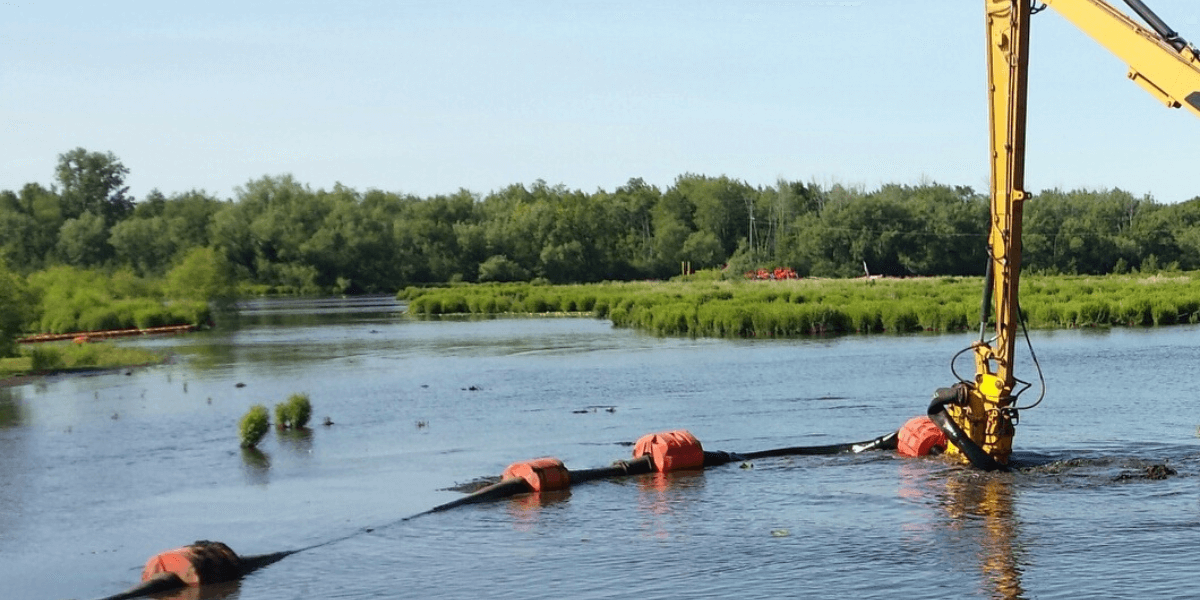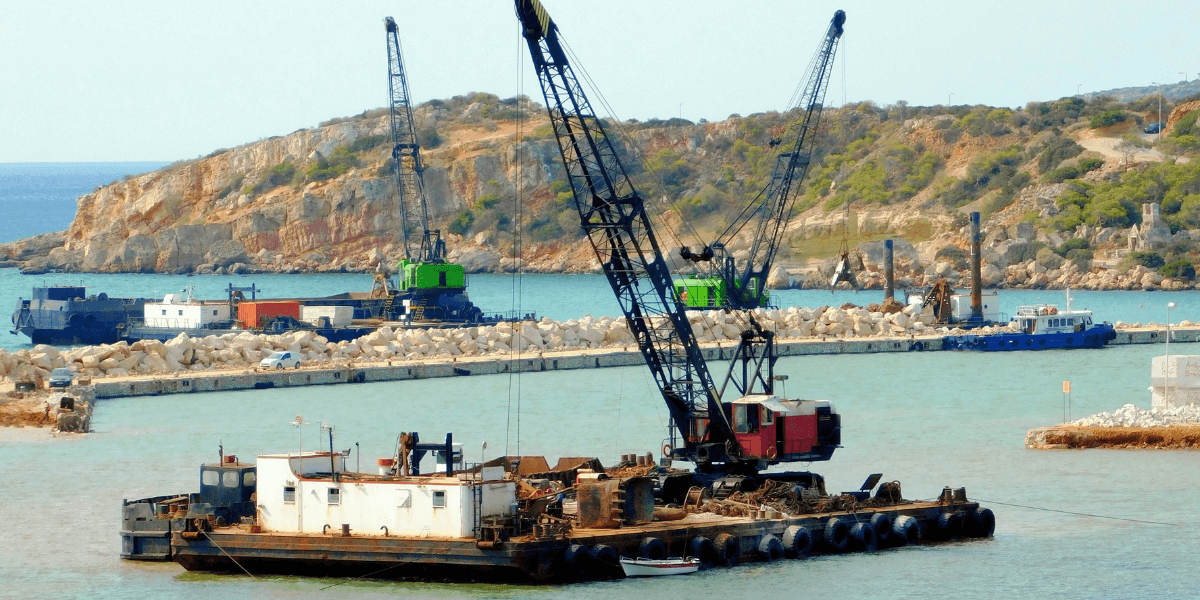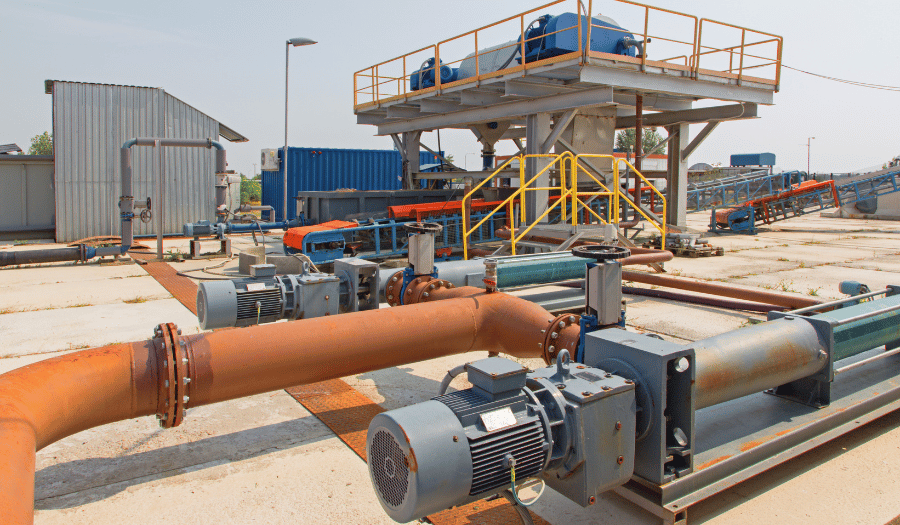1 min read
The Importance Of Dredging
When most people think of dredging, they picture heavy equipment scooping sediment from the bottom of a river or harbor. And while that's part of the...
5 min read
U.S. Aqua Services Oct 14, 2025 10:59:26 AM
.png)
Civil engineering and dredging have always been industries built on innovation. From early canal systems to modern coastal restoration, technology continues to redefine what is possible.In 2025, advancements in artificial intelligence, digital twins, automation, and sustainable design are changing how engineers and dredging professionals plan, monitor, and execute projects. These tools improve accuracy, reduce risks, and strengthen environmental protection across waterways and infrastructure.
How Are Drones Revolutionizing Land Surveying and Dredging Projects?
How Does CAD Software Improve Civil Engineering Design and Precision?
What Role Do Cloud Technologies and Remote Monitoring Play in Modern Engineering Projects?
How Do IoT Sensors and Smart Devices Improve Infrastructure and Safety?
What Is Building Information Modeling (BIM) and Why Is It Vital in 2025?
How Does Big Data Enhance Planning and Risk Management in Engineering?
What Are the Latest Innovations in Water Conservation and Sustainability?
How Is 3D Printing Revolutionizing Civil Engineering and Construction?
Why Should Civil Engineering Firms Embrace Digital Marketing in 2025?
Drones have become an essential tool for surveying, giving engineers faster, safer, and more accurate data collection in difficult terrain.
In both civil engineering and dredging, unmanned aerial vehicles (UAVs) are used to create detailed topographic maps, volume calculations, and 3D models of terrain and waterways. This allows teams to analyze soil conditions, monitor shoreline changes, and measure sediment movement with precision.
For dredging professionals, drones simplify coastal restoration surveys, levee inspections, and environmental monitoring without disturbing ecosystems. When paired with AI image analysis, these systems can detect subtle landscape changes that indicate erosion or flooding risks.
Computer-Aided Design (CAD) software allows engineers to visualize, simulate, and refine projects before construction begins.
Civil engineers use advanced programs such as Autodesk Civil 3D and Bentley MicroStation to model infrastructure, test load capacity, and identify design flaws early. In dredging operations, CAD tools support the creation of precise dredge plans, sediment modeling, and containment systems that meet environmental standards.
Here’s how CAD software compares across common uses:
| Software | Primary Use | Engineering Benefits |
|---|---|---|
Autodesk Civil 3D |
Infrastructure modeling |
Improves accuracy and design visualization |
Bentley MicroStation |
Structural design |
Detects potential issues early |
Fusion 360 |
Component design |
Speeds up prototyping and fabrication |
Cloud computing and remote monitoring enable project teams to collaborate in real time and analyze data instantly from anywhere.
In dredging, these technologies enable supervisors to monitor water depth, equipment performance, and sediment flow remotely. Remote sensors and smart devices collect continuous data, which is then organized and visualized in cloud-based dashboards.
This leads to smarter project management, faster decision-making, and improved safety outcomes. When combined with AI, cloud platforms can also predict maintenance needs before breakdowns occur.
The Internet of Things (IoT) connects equipment, sensors, and systems across a project site to collect data and respond to conditions in real time.
In civil engineering, IoT sensors track structural integrity, vibration levels, and water flow to ensure safety and efficiency. In dredging, these sensors can monitor pump pressure, sediment density, and fuel consumption to improve performance.
Benefits of IoT technology include:
IoT-driven automation has introduced the concept of smart dredging. Systems can now adjust flow rates or cutter head speeds automatically based on live data. These adaptive systems help reduce waste, cut fuel costs, and extend the lifespan of dredging equipment.
Building Information Modeling (BIM) is a digital process that integrates design, materials, and performance data into a single collaborative model.
In 2025, BIM will have become the standard for large civil and dredging projects. Engineers use it to simulate how infrastructure interacts with natural environments, predict sediment flow, and plan maintenance before construction starts.
Digital twins have expanded BIM’s potential by creating virtual replicas of structures such as levees, bridges, and dredging containment areas. These replicas allow continuous monitoring of performance and sustainability over time.
 How Does Big Data Enhance Planning and Risk Management in Engineering?
How Does Big Data Enhance Planning and Risk Management in Engineering?Big data enables engineers and dredging teams to make better decisions by identifying trends and predicting previously unseen outcomes.
By combining data from sensors, weather models, and satellite imagery, big data analytics can predict flood risks, optimize dredging routes, and forecast sediment behavior. Predictive models also identify erosion-prone zones before they damage infrastructure.
AI-driven data tools now convert millions of inputs into actionable insights, helping engineers allocate resources efficiently, reduce environmental impact, and stay compliant with regulations.
Modern water conservation technologies focus on efficiency, resource management, and ecosystem protection.
Examples of sustainable innovations include:
Smart leak detection and flow control systems
Closed-loop dredging that reuses process water
Eco-friendly construction materials
Permeable pavements that reduce runoff
Green infrastructure, like bioswales and natural filtration
These technologies reduce water waste and support long-term environmental goals. U.S. Aqua’s marsh and wetland restoration efforts align with these principles by restoring habitats and protecting coastlines from erosion.
3D printing allows engineers to produce components with greater precision while reducing waste and cost.
From bridges and housing units to seawalls and levees, large-scale 3D printers create complex structures that accelerate timelines and reduce environmental impact. In dredging and marine infrastructure, 3D printing is also used to produce replacement parts such as impellers or hydraulic fittings on-site to minimize downtime.
Advances in reinforced concrete printing and composite materials continue to expand 3D printing’s role in both civil and coastal projects.
Artificial intelligence and automation are transforming how dredging operations are managed.
AI systems can automatically adjust dredge pump speeds, cutter head angles, and material flow in real time to optimize performance. Machine learning algorithms analyze past data to recommend the most efficient dredge routes or predict component wear before failure.
Benefits of AI in dredging:
Improved accuracy of sediment removal
Reduced fuel consumption and emissions
Enhanced productivity through automation
Increased safety through predictive monitoring
Together with GPS and sonar technologies, autonomous dredging systems reduce manual oversight, improve safety, and increase operational accuracy. These tools reflect U.S. Aqua’s commitment to technological innovation and environmental responsibility.
Digital marketing is now a vital part of building trust and visibility for engineering and dredging firms.
SEO-optimized websites, project case studies, and educational content help firms connect with potential clients and demonstrate expertise. For U.S. Aqua, sharing thought leadership content highlights its role as a technology-driven leader in dredging and restoration while reaching engineers, contractors, and municipalities who need reliable partners.
In a data-driven world, effective digital marketing enables engineering firms to expand their presence, enhance credibility, and seize new opportunities.
AI automation, IoT sensors, drones, and digital twins are driving major improvements in project efficiency, safety, and environmental monitoring.
U.S. Aqua uses amphibious vehicles, real-time data monitoring, and precision dredging tools to enhance productivity and reduce environmental impact.
Sustainability helps protect water resources, minimize waste, and extend infrastructure lifespan, supporting both ecological and economic goals.
Drones capture high-resolution aerial data that allows engineers to track shoreline changes, sediment movement, and restoration progress accurately.
Technology continues to shape how civil engineering and dredging professionals build, restore, and protect the environments we depend on. At U.S. Aqua Services, innovation is built into every operation.
From amphibious dredging equipment to remote monitoring systems and AI-supported operations, our team helps clients complete projects faster, safer, and more sustainably.
Contact U.S. Aqua Services today to see how our technology-driven approach can support your next dredging or coastal restoration project.
U.S. Aqua Services was created to support the dredging process in advancing commerce and responding to its many challenges. To accomplish this, our dredging company assembled an exceptional group of experienced individuals and a diverse inventory of dredge equipment.
We offer dredging equipment rental services so you can have access to the latest and greatest in dredging technology without having to pay to maintain it, transport, and store it, along with dewatering services.
With an emphasis on mobility, dependability, durability, diversity, efficiency, and safety, our dredging rental company can ensure that our different types of dredging systems are easy to move through any terrain and can work in the most rugged and remote environments. Our multi-function hydraulic systems are built with jetting and mechanical options that can efficiently move loose sediment or stiff layers of clay.
US Aqua services also and maintains a ready fleet of amphibious equipment capable of completing dredging projects in some of the harshest and most remote environments. U.S Aqua is also the dealer for Louisiana of the amphibious vehicle Fat Truck. No matter the size or scope of the job or the remoteness of your work location, you can rely on Fat Truck’s industrial off-road utility vehicles to get the job done right.

1 min read
When most people think of dredging, they picture heavy equipment scooping sediment from the bottom of a river or harbor. And while that's part of the...

Subsurface dredging plays a pivotal role in maintaining waterway accessibility, supporting infrastructure projects, and restoring delicate ecosystems...

Dredging is a vital activity for maintaining waterway navigability, environmental cleanup, and resource extraction. After dredging, the material...